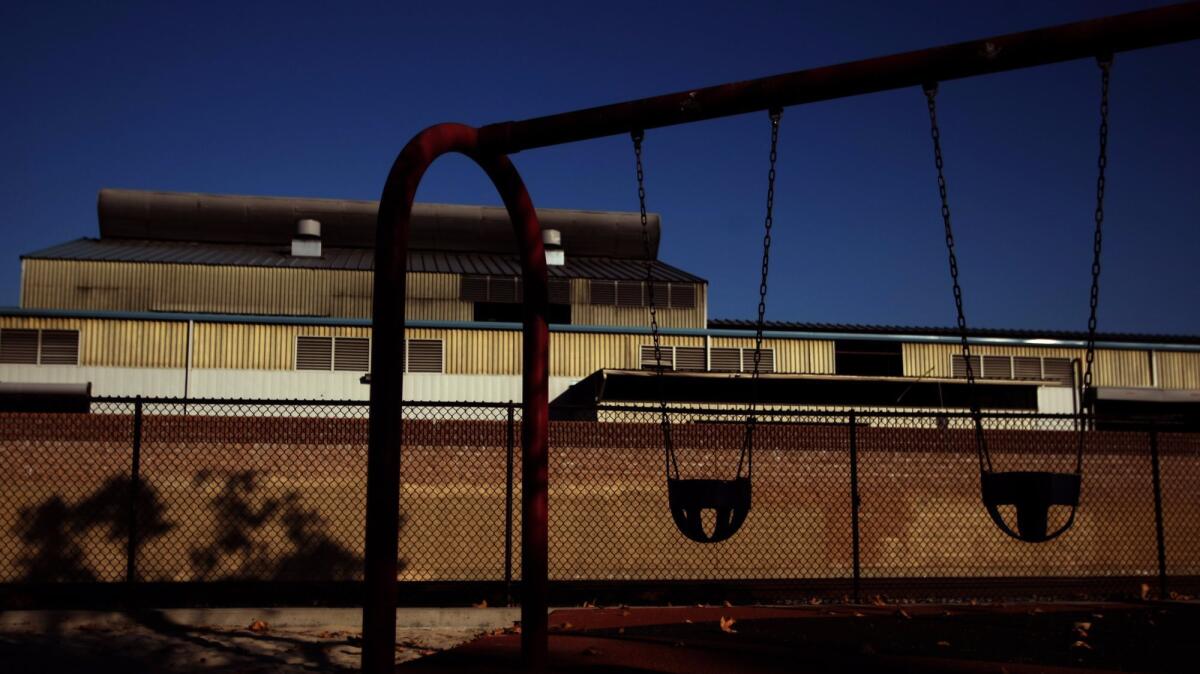Air regulators find a cancer-causing metal at 350 times normal levels in Paramount. Now they’re looking for the source

Air quality regulators are investigating metal-processing facilities in the city of Paramount after detecting a potent cancer-causing metal at 350 times normal levels.
After discovering high levels of the carcinogen hexavalent chromium late last month, the South Coast Air Quality Management District intensified an ongoing investigation, inspecting businesses in the southeast Los Angeles County community in a search for who might be responsible.
Philip Fine, a deputy executive officer for the air district, said hexavalent chromium readings of 26 nanograms per cubic meter, detected on Oct. 27 by an air-monitoring device deployed near Madison Street and Minnesota Avenue, were among the highest he could recall.
“We’re really focused on finding the precise source of these high levels,” Fine said. “As soon as we can, we will be acting aggressively to stop the emissions.”
Toxic hot spots still exist in Los Angeles. … They can harm children, the elderly, and we need to do something about it.
— Jane Williams, California Communities Against Toxics
Hexavalent chromium, emitted by chrome platers, metal finishers and facilities in the aerospace industry, is known to cause lung cancer.
AQMD officials emphasized that the high levels detected, though concerning, are not an immediate threat. Breathing the compound poses an increased cancer risk over years or decades of exposure.
A four-page summary of monitoring results released by the air district says that although the highest concentrations of the pollutant were detected in “mostly industrial areas,” levels detected closer to residential neighborhoods were also elevated and “heighten the need to take swift action to identify and mitigate the source or sources of hexavalent chromium.”
As part of the investigation, air district officials said they dispatched facility inspectors and enforcement personnel to identify any facilities that may be out of compliance with air quality rules, lacking permits or operating under the radar. The agency said it has made monitoring the air in Paramount and finding the source of the pollution its staff’s highest priority.
People have complained of burning metallic odors in Paramount for years. In 2012, spurred by dozens of complaints from an elementary school teacher, the air district launched an investigation that focused on Carlton Forge Works, a metal-grinding operation.
The following year the South Coast air district started monitoring for air toxics in the community and implementing measures to reduce odors and emissions of hexavalent chromium, nickel and other toxic metals from the business. In 2014, the agency revealed that monitors had detected elevated levels of nickel, a carcinogen that can harm the lungs.
Carlton Forge Works has made improvements that have reduced metal dust emissions from its grinding operations and has not detected hexavalent chromium in its exhaust since completing upgrades to its pollution controls last year, according to a company spokeswoman.
The air district’s recent sampling results “suggest that there is a significant source of hexavalent chromium several blocks to the west of, and upwind of, CFW,” spokeswoman Jenny Dudikoff said.
In August, air district officials told residents at a public meeting that despite the improvements made at that facility, levels of nickel and hexavalent chromium in the community’s air remained well above background levels. They pledged to take action and to expand their investigation to find where the pollutants were coming from.
As part of that initiative, late last month regulators deployed nine additional air quality monitors in industrial areas of Paramount that are upwind from Carlton Forge Works. Officials said they received the monitoring results showing very high readings on Wednesday Nov. 2. They notified the public on Friday, and have scheduled a public meeting Wednesday evening in Paramount to discuss the findings.
Residents and environmental activists have for years urged regulators to take action to control toxic air pollution from what they say is a heavy concentration of industrial metal-working operations in the predominantly working-class, Latino community.
Jane Williams, who heads the group California Communities Against Toxics, said the recent discovery of high pollution readings “is proof positive that toxic hot spots still exist in Los Angeles despite our regulatory infrastructure … They can harm children, the elderly, and we need to do something about it.”
Williams said she reviewed government and business records and mapped at least a dozen metal plating, casting, polishing and finishing facilities and other potential sources of hexavalent chromium within a few blocks of where regulators detected the high readings.
The Los Angeles County Department of Public Health said staff was analyzing the air monitoring results to determine what actions might be necessary to protect workers and residents in the area.
While there may be more than one operation responsible, “to get these high levels our expectation is that there will be a major, unpermitted release at at least one of the facilities,” said Angelo Bellomo, a deputy director for the health department.
The South Coast air district has long proposed new rules on metalworking facilities across Southern California to clamp down on their toxic emissions into surrounding communities. At least three sets of rules to cut pollution from operations that forge, grind, finish and treat metal are scheduled for consideration by the air quality board starting next year. Records show several facilities that would be subject to those regulations are in Paramount.
Twitter: @tonybarboza
ALSO
Developer sues over Coastal Commission’s rejection of Banning Ranch project
Stockton mother faces jail time for selling homemade ceviche through Facebook
Family fears mother of two who vanished while jogging in Northern California was abducted
UPDATES:
6:05 p.m.: This article was updated with comments from Carlton Forge Works and the Los Angeles County Department of Public Health.
This article was originally published at 1:30 p.m.
More to Read
Sign up for Essential California
The most important California stories and recommendations in your inbox every morning.
You may occasionally receive promotional content from the Los Angeles Times.











